Birds are known for their stunning diversity, but some stand out in a truly enigmatic way. Imagine a bird that is mostly black but with eyes that burn with a fiery shade of red. These birds are nature’s riddles, captivating observers with their striking appearance. In this blog post, we’ll embark on an intriguing journey to explore the world of black birds with red eyes. We’ll delve into what makes them so fascinating, where they choose to live, and what secrets lie behind their crimson gaze. Join us as we unveil the mysteries of these Black Birds with Red eyes
List of Black Birds with Red Eyes
Black Guan:
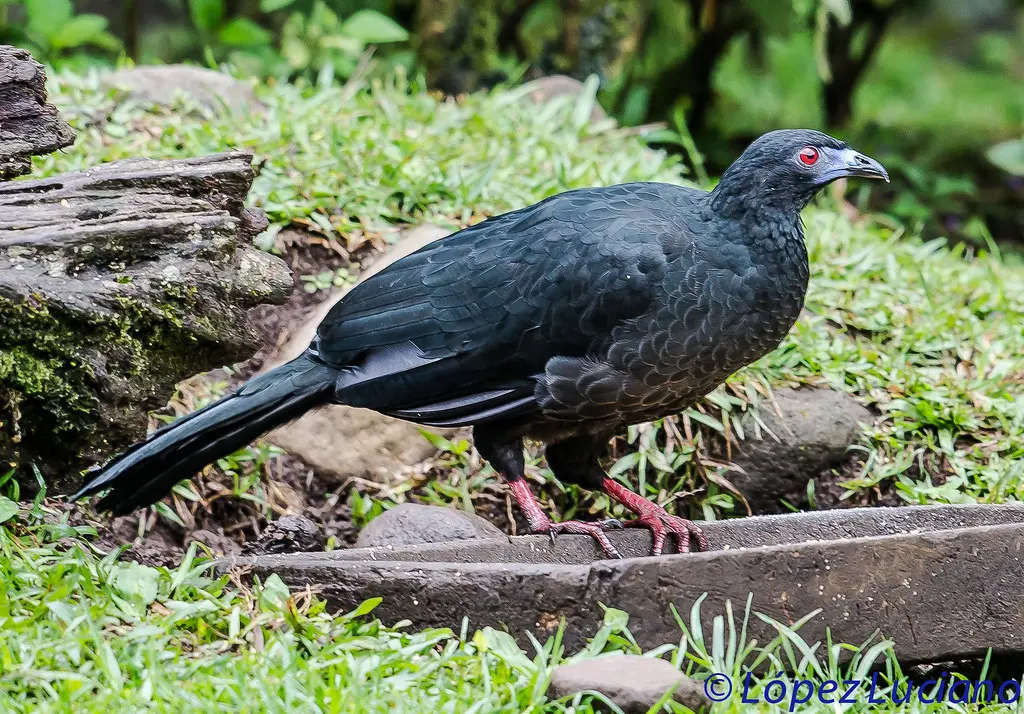
- Scientific name: Chamaepetes unicolor
- Lifespan: Information not readily available.
- Wingspan: Information not readily available.
- Native to: Central and South America, particularly in regions from Mexico to Honduras.
The Black Guan is an intriguing bird species native to Central and South America, particularly in countries like Costa Rica, Panama, and Colombia. It belongs to the family Cracidae, which includes turkey-like birds. The Black Guan stands out with its predominantly black plumage, adorned with striking white markings on its wings and tail.
These guans are primarily found in cloud forests and montane forests at higher elevations. They are known for their herbivorous diet, consisting of fruits, leaves, and flowers. Black Guans often forage in the treetops, using their strong bills to extract food. They are generally social birds and are often seen in small groups.
Metallic Starling:
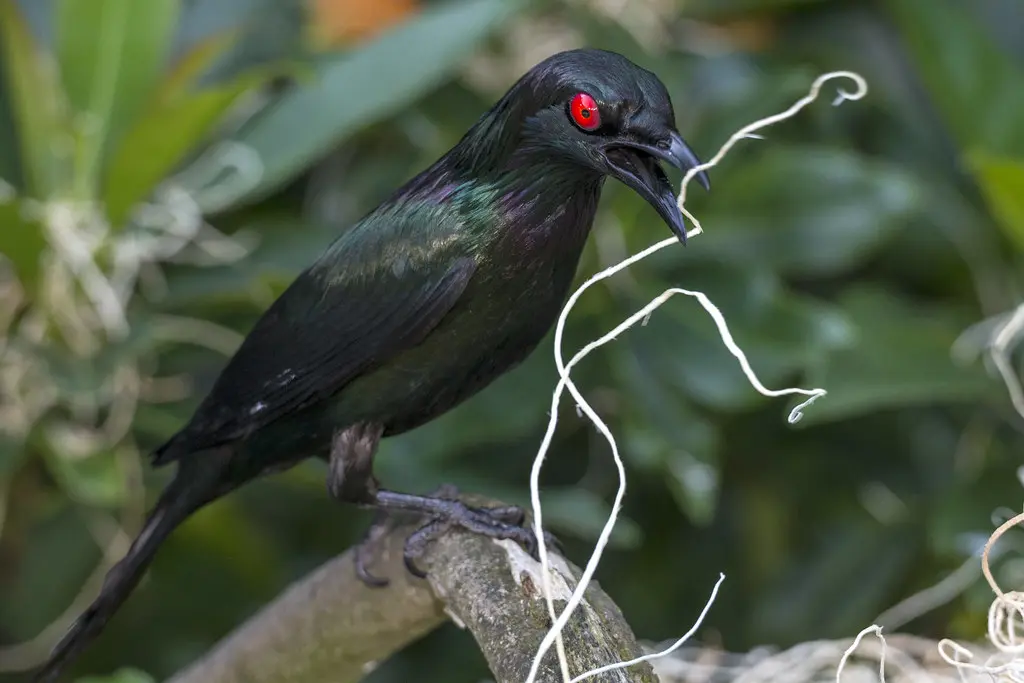
- Scientific name: Aplonis metallica
- Lifespan: Information not readily available.
- Wingspan: Information not readily available.
- Native to: Various regions in Oceania, including parts of Australia, New Guinea, and nearby islands.
The Metallic Starling is a captivating bird species native to various regions across Southeast Asia and the western Pacific. Its name perfectly captures its remarkable appearance. These starlings are renowned for their iridescent, metallic plumage that gleams with hues of green, blue, and purple. Their strikingly bright eyes and contrasting dark wings and tails further enhance their visual appeal.
Metallic Starlings are highly social birds, often forming large flocks that engage in synchronized aerial displays. They are skilled vocalists, with a repertoire of melodious calls and songs. Their diet primarily consists of fruits and nectar, making them important pollinators in their ecosystems. These starlings are known for their adaptability to a range of habitats, including urban areas, and their ability to thrive in a variety of environments.
American Coot
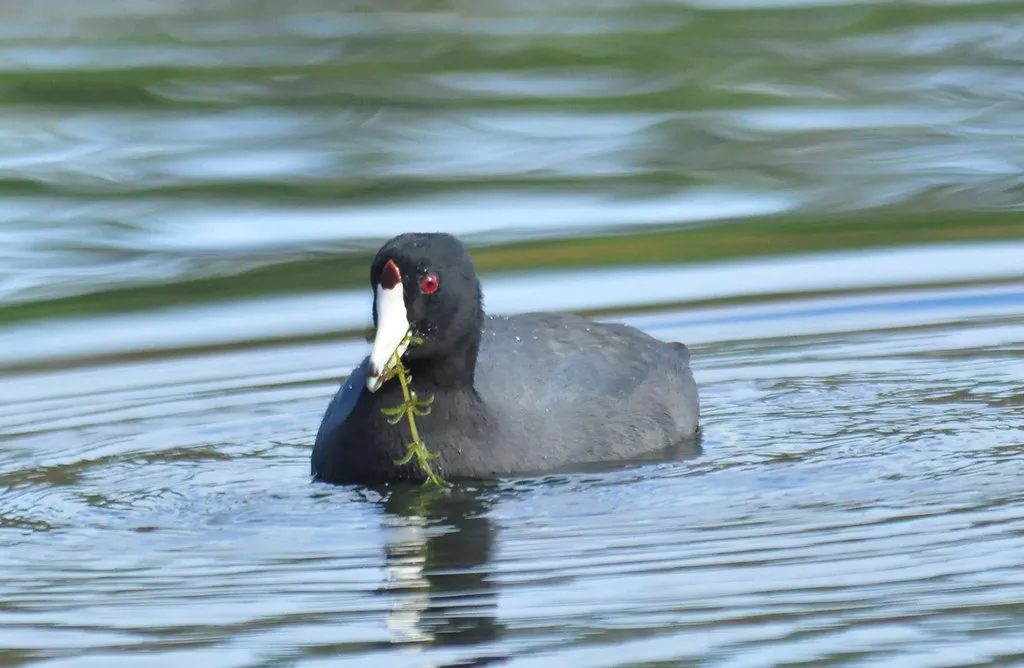
Image Source
- Scientific name: Fulica americana
- Lifespan: 9 years
- Size: 15 inches
- Native to: United States from California to Florida
The American Coot (*Fulica americana*) is a medium-sized waterbird found throughout North America. Although it resembles a duck in some ways, it belongs to a different family, the Rallidae, and is known for its distinctive features. Adult American Coots have dark gray to black plumage, a white bill, and a distinctive white triangular patch on their foreheads. Their legs are long and have lobed toes, which make them skilled swimmers.
These coots are often found in a variety of aquatic habitats, including lakes, ponds, marshes, and slow-moving rivers. They are primarily herbivorous, feeding on aquatic plants, algae, and various invertebrates.
American Coots are appreciated for their adaptability to different wetland habitats and their social behaviors. They are often seen in large flocks during the non-breeding season, and their calls, which include a variety of clucking and cackling sounds, are familiar sounds in wetland environments.
Phainopepla
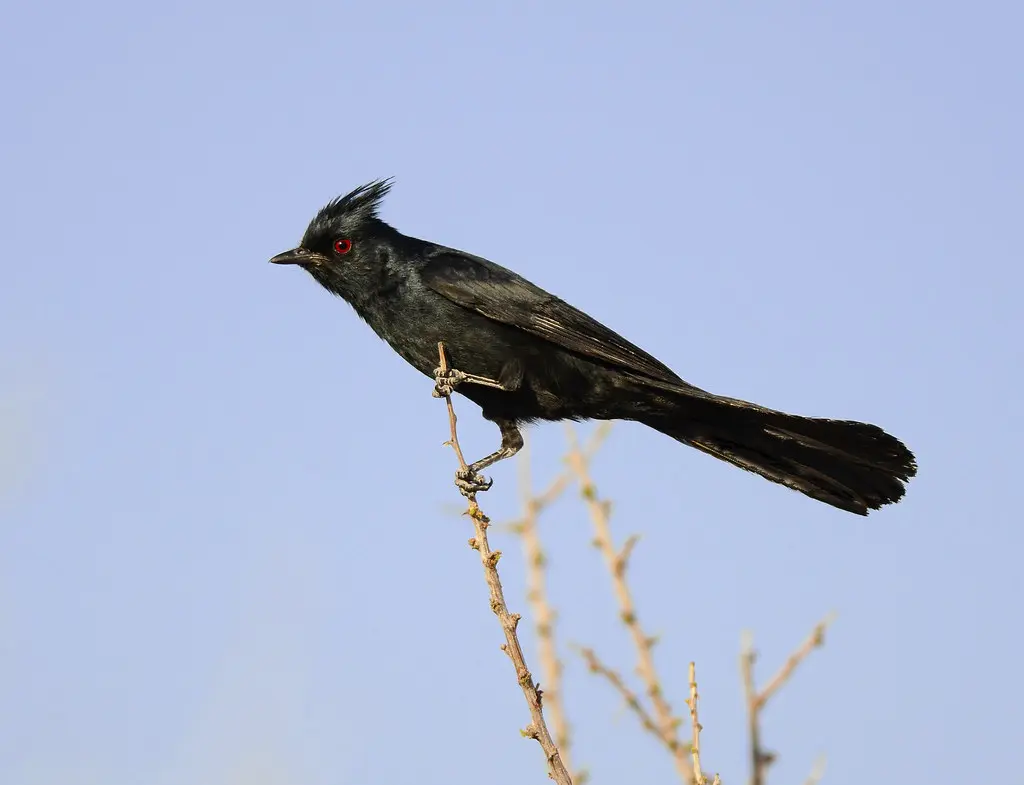
- Scientific name: Phainopepla nitens
- Lifespan: Typically around 5 to 10 years
- Wingspan: Approximately 25 to 30 cm (9.8 to 11.8 inches)
- Native to: Southwestern United States and Mexico.
The Phainopepla is a small, striking songbird native to the southwestern United States and parts of Mexico. Adult Phainopeplas have a distinctive appearance with predominantly glossy black plumage. Males have bright red eye patches, while females have more subdued gray eye patches.
These birds are often found in desert and arid scrubland habitats, including mesquite woodlands. They are primarily insectivorous, feeding on a diet of insects and other small invertebrates, as well as berries and fruit.
Phainopeplas are appreciated for their unique appearance and their melodious, flute-like calls. They are agile fliers and are known for their aerial foraging, capturing insects on the wing. They are a charismatic species often associated with desert habitats.
Western Grebe
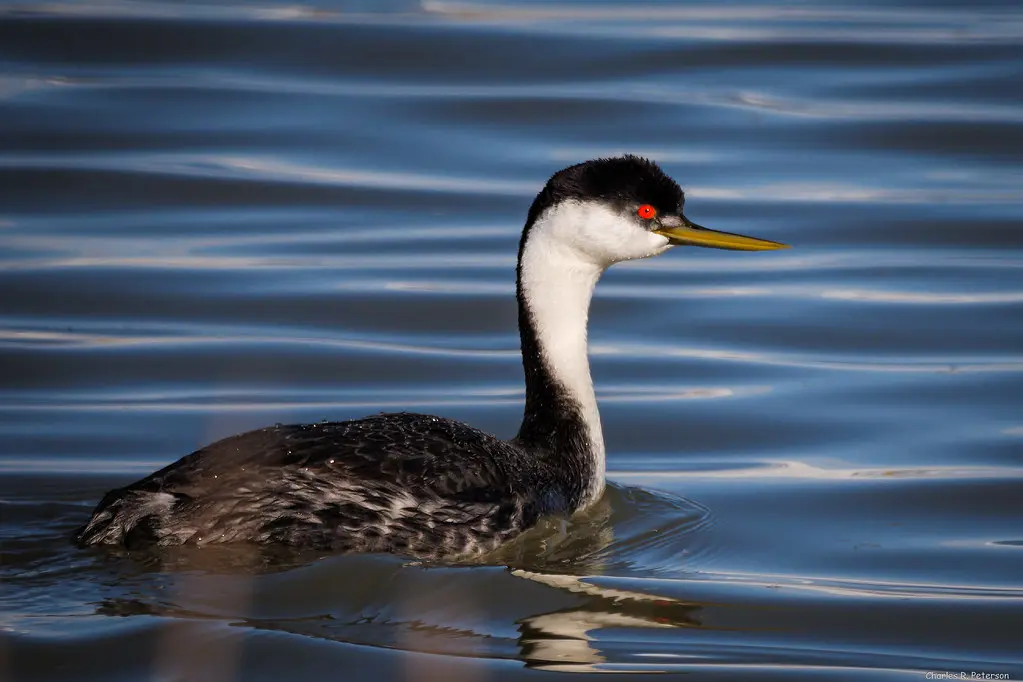
- Scientific name: Aechmophorus occidentalis
- Lifespan: Typically around 5 to 10 years.
- Wingspan: Approximately 71 to 76 cm (28 to 30 inches).
- Native to: Western North America, often found in freshwater lakes.
The Western Grebe is a large waterbird found in western North America, particularly in freshwater lakes and ponds. Adult Western Grebes have a striking appearance with black upperparts, a white neck and underparts, and distinctive long, slender necks. They have striking red eyes and a black crown that extends to their eyes during the breeding season.
These grebes are often found in larger bodies of freshwater, where they are known for their graceful courtship displays, including synchronized swimming and elaborate “rushing” behavior. They are skilled divers and primarily feed on fish and aquatic invertebrates.
Western Grebes are appreciated for their elegance and striking courtship displays, which are a spectacle in many Western American lakes during the breeding season. They are also known for their eerie and haunting calls that are often heard in their aquatic habitats.
Greater Coucal
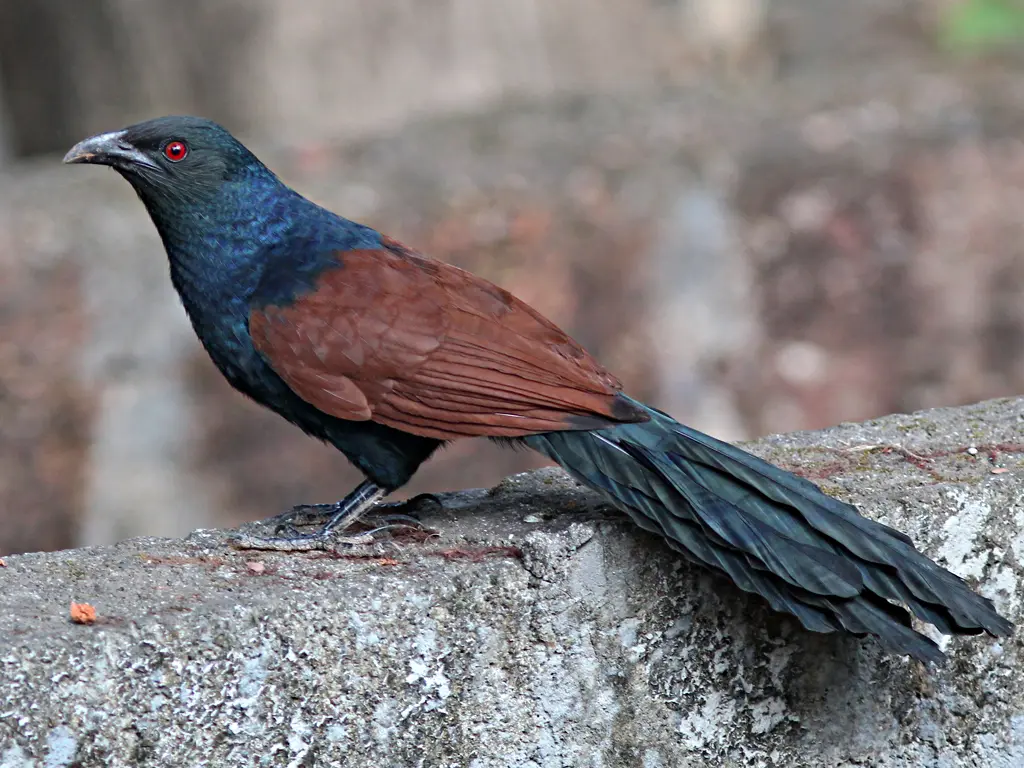
- Scientific name: Centropus sinensis
- Lifespan: Typically 3-5 years in the wild.
- Size: Large cuckoo; about 17-24 inches (43-61 cm) in length.
- Range: The Greater Coucal has a wide distribution across South Asia, Southeast Asia, and parts of East Asia
The Greater Coucal also known as the Crow Pheasant, is a large, ground-dwelling bird found in parts of Asia and the Indian subcontinent. Adult Greater Coucals have a distinctive appearance with black plumage, a long tail, and a prominent, curved bill. Their eyes are red, and they have bare red skin around their eyes.
These coucals are often found in a variety of habitats, including woodlands, grasslands, and wetlands. They are omnivorous, feeding on a diet of insects, small vertebrates, eggs, and fruits.
Greater Coucals are appreciated for their unique appearance and their distinctive calls, which include a series of deep, resonant “hoop” or “coop” sounds. They are often heard before they are seen, as they are known for their loud vocalizations. They are an iconic and charismatic species in their range.
Bronzed Cowbird
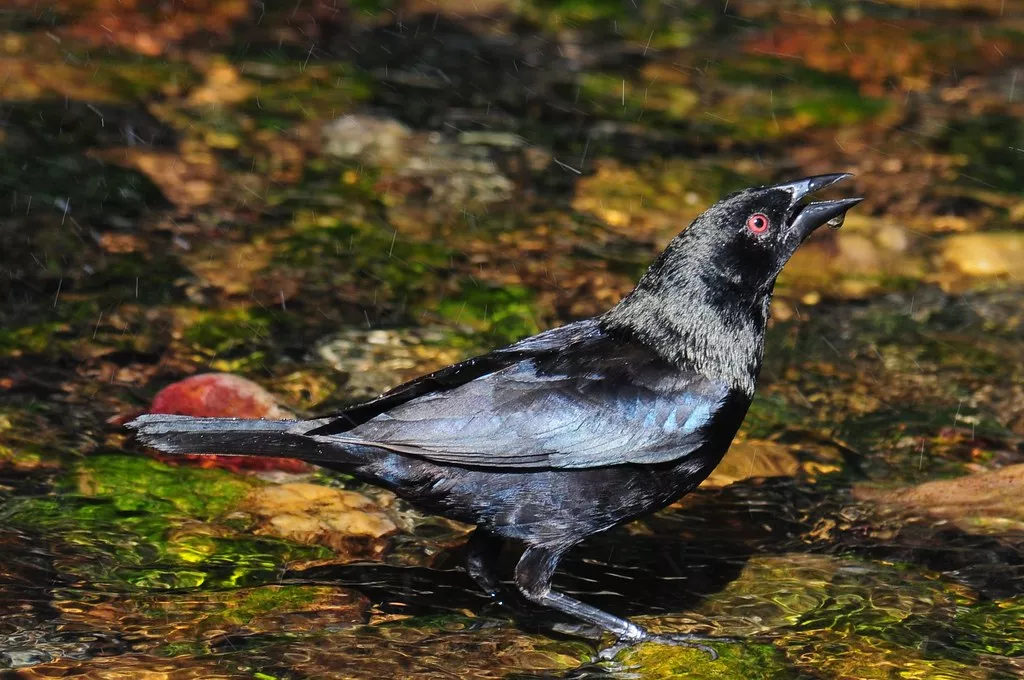
Image Source
- Scientific name: Molothrus aeneus
- Lifespan: 10-15 years
- Size: 7 inches
- Native to: United States
The Bronzed Cowbird is a songbird found in parts of the Americas, primarily in Mexico and Central America. Adult male Bronzed Cowbirds have a glossy, bronzed-green plumage with a purplish sheen on their heads and necks. Females, on the other hand, have a more subdued brownish-gray plumage.
These cowbirds are often found in open habitats, including grasslands, savannas, and agricultural areas. They are obligate brood parasites, meaning they do not build their own nests but instead lay their eggs in the nests of other bird species, leaving the host species to raise their chicks.
Bronzed Cowbirds are appreciated for their unique breeding strategy and their striking appearance, especially the males. They are often seen in mixed-species flocks and are known for their melodious calls and vocalizations.
Common Loon:

- Scientific name: Gavia immer
- Lifespan: Up to 20 years
- Size: 58-76 centimeters (23-30 inches)
- Weight: 1.4-3.2 kilograms (3-7 pounds)
- Origin: North America (breeding in arctic regions)
The Common Loon is a large and iconic waterbird found in North America, primarily in freshwater lakes and ponds. Adult Common Loons have a striking appearance with a black head and neck, a white belly, and a distinctive checkerboard pattern on their back. They have red eyes and a long, dagger-like bill.
These loons are known for their expert diving and swimming abilities. They are skilled underwater predators, feeding on fish and aquatic invertebrates. Their haunting, eerie calls are a characteristic sound in northern lakes during the breeding season.
Common Loons are appreciated for their striking appearance and unique vocalizations, which are often associated with wilderness areas in North America. They are often considered symbols of remote, pristine northern lakes and are a sought-after species for birdwatchers.
Asian koel
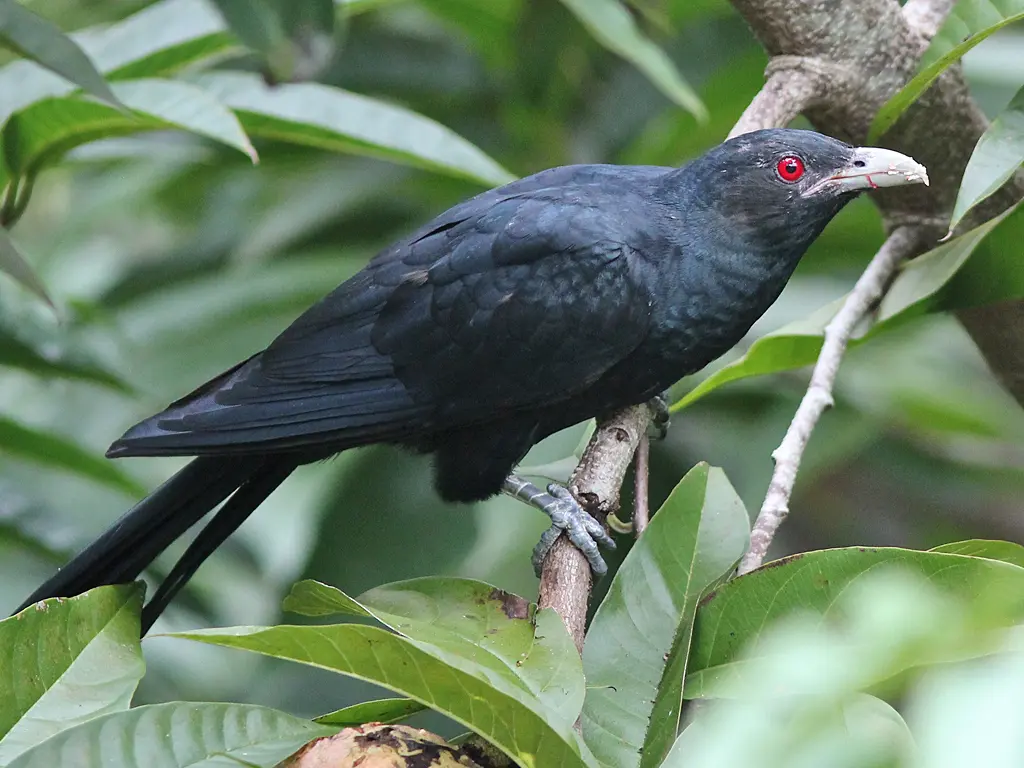
- Scientific name: Eudynamys scolopaceus
- Lifespan: 12 to 15 years
- Size: 15 inches
- Native to: tropical southern Asia from Iran, Pakistan, India, Bangladesh and Sri Lanka to southern China and the Greater Sundas
The Asian Koel is a medium-sized cuckoo species found in South Asia, Southeast Asia, and parts of Australia. Adult male Asian Koels have glossy black plumage with striking red eyes and a long tail. Females, on the other hand, have brownish plumage with streaks.
Asian Koels are known for their distinctive calls, which are often described as a series of loud, ascending, and melodious “ko-el” calls. They are frequently heard during the breeding season, but they can be elusive to spot due to their secretive nature.
These cuckoos are often found in a variety of habitats, including woodlands, gardens, and urban areas. They are primarily frugivorous, feeding on fruits and berries, but they are also known to consume insects and other small prey.
Asian Koels are appreciated for their vocalizations, and they are sometimes associated with cultural and folklore traditions in their range. In some regions, their calls are considered harbingers of the monsoon season.
African River Martin
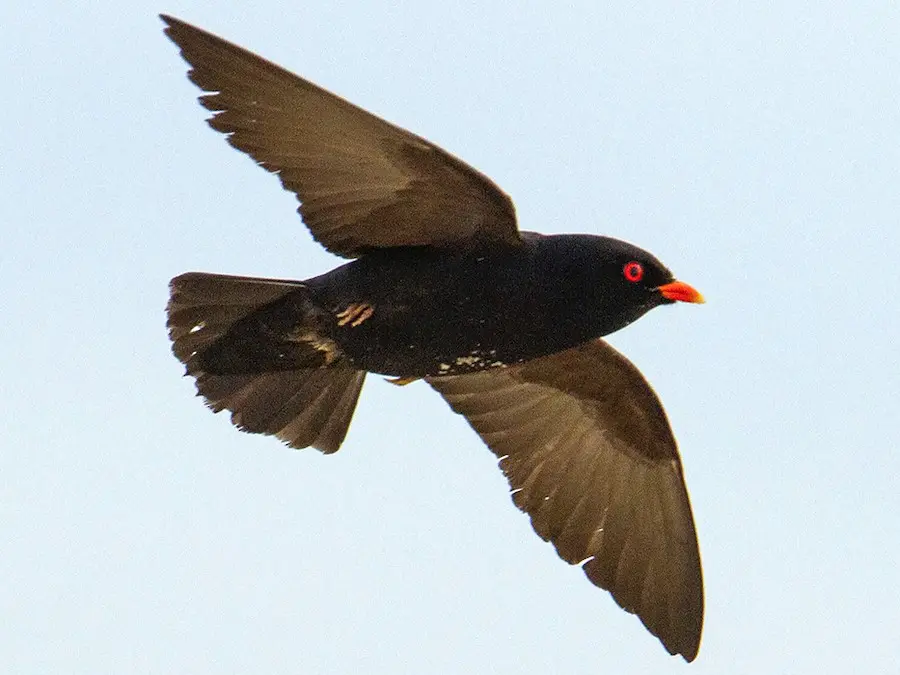
- Scientific name: Pseudochelidon eurystomina
- Lifespan: Information on lifespan is limited.
- Size: Small swallow-like bird; specific measurements may vary.
- Origin: Native to parts of sub-Saharan Africa, particularly along riverine habitats, although it’s a rare and poorly understood species.
The African River Martin is a species of swallow found in sub-Saharan Africa. It is one of the least-known bird species, and there have been very few confirmed sightings of this bird in recent years. As a result, the African River Martin’s current status and range are uncertain, and it is considered critically endangered.
Adult African River Martins are characterized by their blackish plumage and distinctive white rump and tail feathers.
Despite its elusive nature and limited information available, the African River Martin is appreciated for its unique status as an African swallow species. Efforts are ongoing to better understand and conserve this rare and enigmatic bird.
Asian Fairy-bluebird

- Scientific name: Irena puella
- Lifespan: Typically 5-10 years
- Size: Medium-sized passerine; about 8-10 inches (20-25 cm) in length
- Origin: Found in parts of South and Southeast Asia, often in forests and wooded areas. These birds are known for their vibrant blue plumage.
The Asian Fairy-bluebird is a striking and colorful bird species found in South and Southeast Asia. Adult male Asian Fairy-bluebirds have brilliant, iridescent blue plumage, black markings around their eyes, and a contrasting black tail. Females, in contrast, have predominantly olive-green plumage with blue on their wings and tail.
These fairy-bluebirds are often found in forests, gardens, and wooded habitats. They primarily feed on a diet of fruits, berries, and insects. They are known for their graceful and agile flight as they move through the canopy in search of food.
Asian Fairy-bluebirds are appreciated for their vibrant colors, especially the males, and their melodious, flute-like calls. They are a delight to observe in their natural habitats and are often associated with forested landscapes in Asia.
Asian Glossy Starling
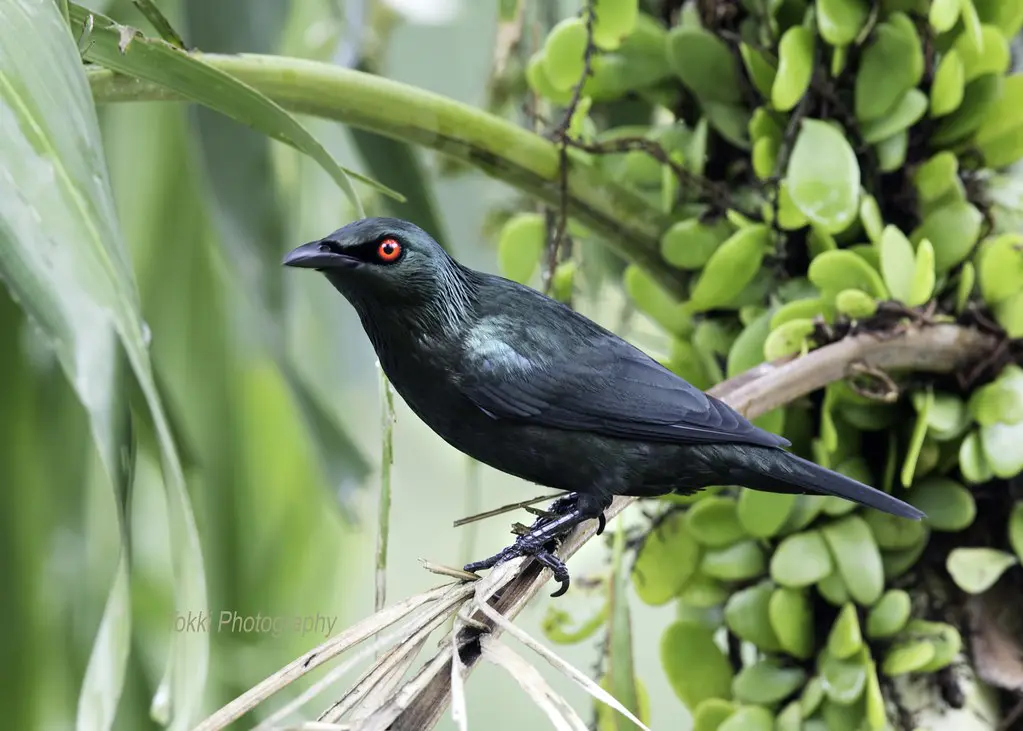
- Scientific name: Aplonis panayensis
- Lifespan: Typically 5-10 years
- Size: Small to medium-sized starling; around 7-9 inches (18-23 cm) in length
- Origin: Native to various parts of Asia, often found in a range of habitats including forests, urban areas, and cultivated fields.
The Asian Glossy Starling is a medium-sized starling found in various parts of Asia, including South and Southeast Asia. Adult Asian Glossy Starlings have glossy, iridescent plumage that can appear predominantly black or purplish-blue, depending on the lighting conditions. They have bright red eyes and distinctive yellow-orange bills.
These starlings are often found in a variety of habitats, including woodlands, gardens, and urban areas. They are omnivorous, feeding on a diet of fruits, insects, and nectar.
Asian Glossy Starlings are appreciated for their striking appearance, especially their iridescent plumage, which can be quite dazzling when caught in the right light. They are often seen in noisy flocks and are known for their vocalizations, which include a variety of whistles, chatters, and calls.
Spangled Drongo
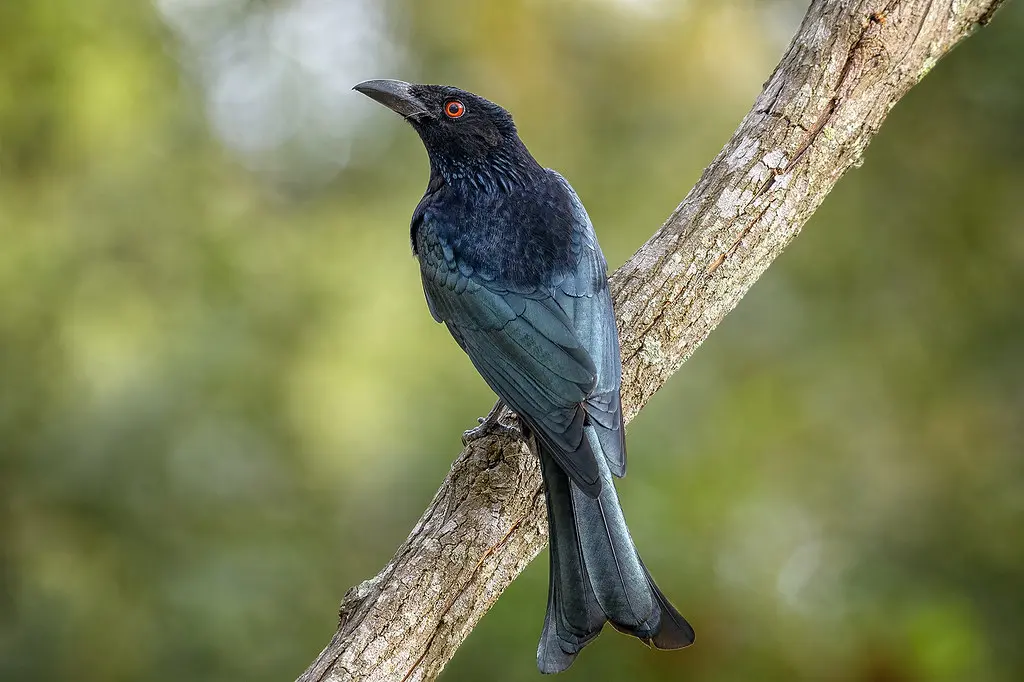
- Scientific name: Dicrurus bracteatus
- Lifespan: Typically around 5 to 10 years.
- Wingspan: Approximately 30 to 40 cm (11.8 to 15.7 inches).
- Native to: Northern and Eastern Australia, as well as nearby islands.
The Spangled Drongo is a medium-sized songbird found in parts of Australia, Southeast Asia, and the western Pacific. Adult Spangled Drongos have predominantly glossy black plumage with distinctive iridescent spangles on their wings and tail, which shimmer in the sunlight. They have red eyes and a deeply forked tail.
These drongos are often found in a variety of habitats, including rainforests, woodlands, and gardens. They are skilled aerial foragers, capturing insects on the wing. They are also known to mimic the calls of other bird species.
Spangled Drongos are appreciated for their striking and iridescent plumage, as well as their vocal mimicry. They are known for their melodious calls and mimicry of other bird species’ songs and sounds. They are charismatic and agile birds, often seen perched in the canopy or darting through the trees while foraging for insects.
Inaccessible Island Rail:
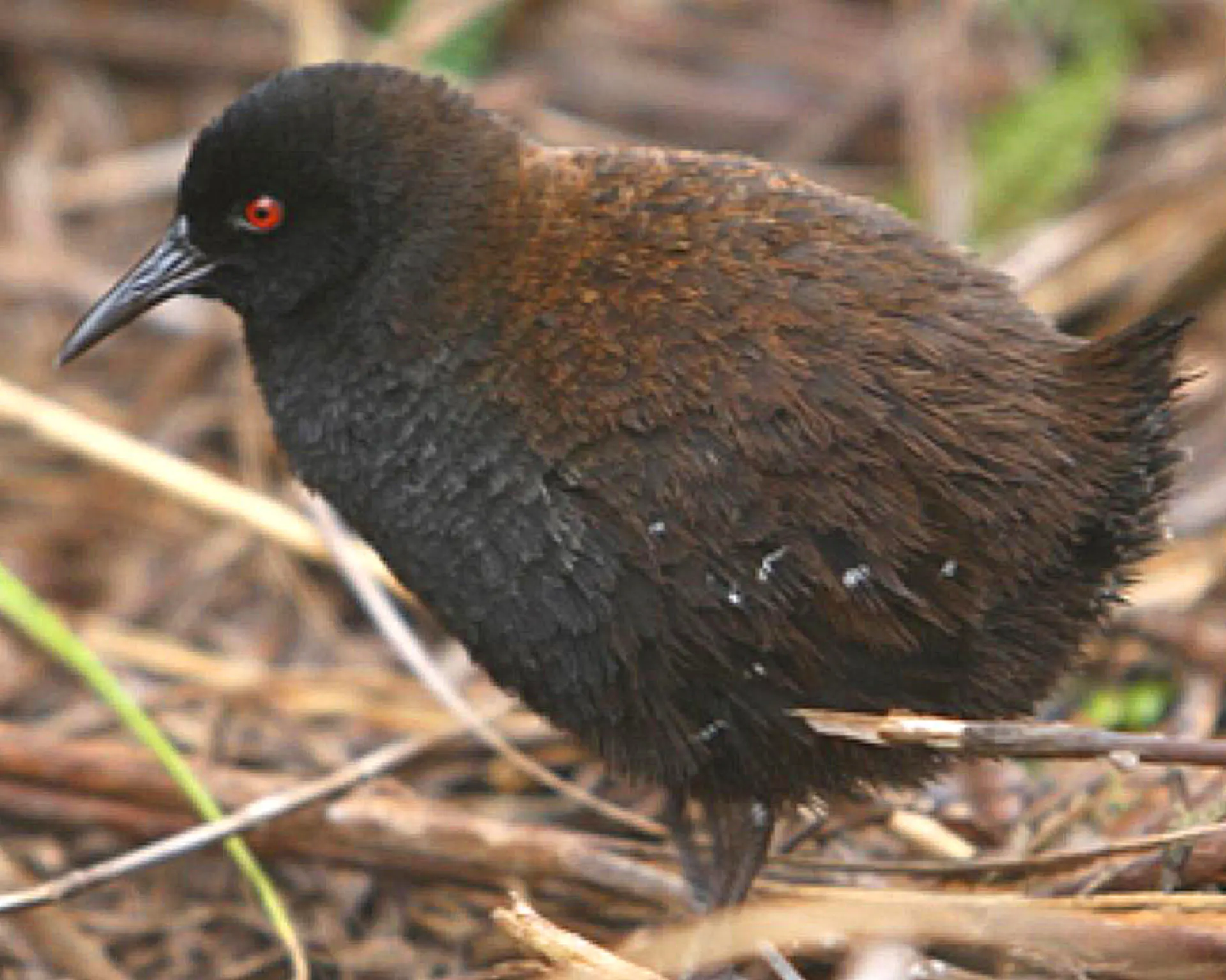
- Scientific name: Atlantisia rogersi
- Native to: Inaccessible Island in the South Atlantic Ocean, part of the Tristan da Cunha archipelago.
The Inaccessible Island Rail is a unique and highly localized bird species that is native to Inaccessible Island, a remote and uninhabited island in the South Atlantic Ocean. These rails are intriguing due to their isolation on this island, which is part of the Tristan da Cunha archipelago.
Inaccessible Island Rails have a distinctive appearance, characterized by their brown plumage and short wings. They are flightless, a trait commonly observed in island-dwelling birds. Their limited range and isolation make them particularly vulnerable to environmental changes and introduced predators. Conservation efforts are crucial for the survival of this rare and enigmatic bird species, which is considered an important symbol of the unique biodiversity of isolated oceanic islands.
White-Winged Chough

Image Source
- Scientific name: Corcorax melanorhamphos
- Lifespan: 16 years
- Size: 18 in
- Native to: eastern Australia
The White-winged Chough is a distinctive and social bird native to Australia. Adult White-winged Choughs have glossy black plumage, bright red eyes, and striking white patches on their wings and their uniquely curved, white-tipped bills.
These choughs are often found in eucalyptus woodlands, forests, and scrubland habitats. They are known for their strong social bonds and cooperative breeding behaviors. They build large communal nests made of sticks and mud, and multiple individuals within a group participate in nest construction and chick-rearing.
White-winged Choughs are appreciated for their unique appearance and complex social structure. They are often seen foraging on the ground for insects, seeds, and other food items, and their melodious calls are a characteristic sound in their habitat.
Dusky Tit

- Scientific name: Melaniparus funereus
- Lifespan: Approximately 2-5 years
- Size: Small bird; about 4-5 inches (10-13 cm) in length
- Origin: Found in parts of Africa, often in forests and woodlands. This species is known for its distinctive black plumage.
The Dusky Tit is a small songbird found in parts of Asia, primarily in the Himalayan region and surrounding areas. Adult Dusky Tits have a predominantly dark plumage, with a grayish-black head, back, and wings, and a white belly. They have distinctive pale eyes.
These tits are often found in coniferous and mixed forests, where they forage for insects, spiders, and seeds. They are known for their active and acrobatic foraging behavior, often hanging upside down to search for food.
Dusky Tits are appreciated for their unique appearance and their agile movements in the treetops. They are known for their varied vocalizations, including melodious whistles and calls, which they use for communication within their flocks.
African Oystercatcher
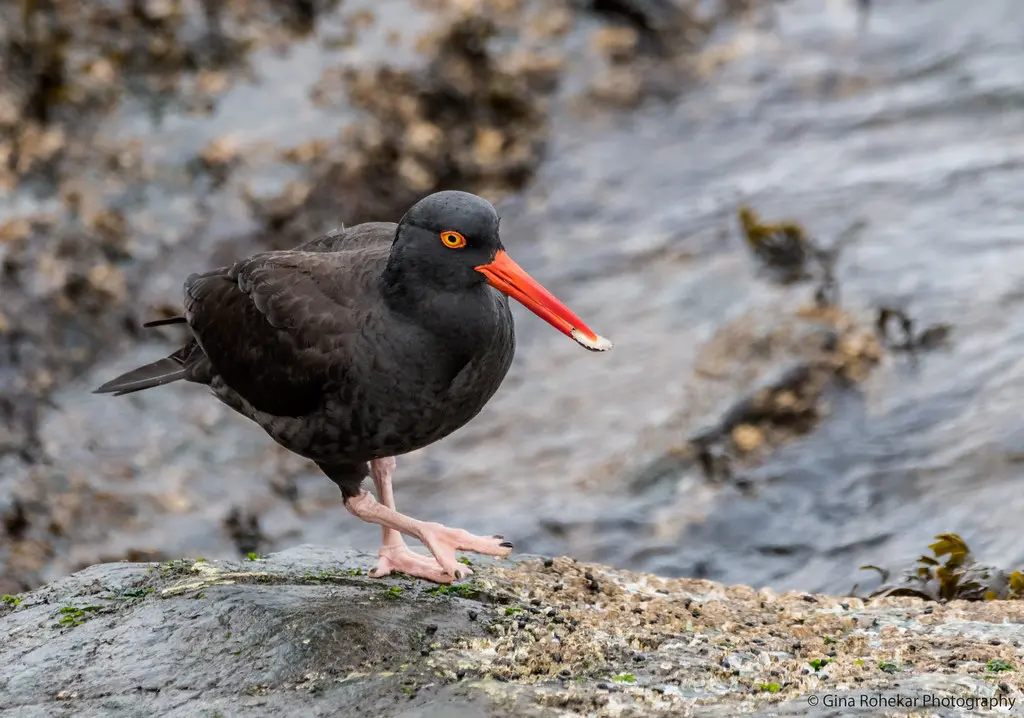
- Scientific name: Haematopus moquini
- Lifespan: Typically 15-20 years
- Size: Medium-sized shorebird; about 17-19 inches (43-48 cm) in length
- Origin: Native to the coastal regions of southern Africa, often found along rocky shores and sandy beaches.
The African Oystercatcher is a striking shorebird found along the coasts of South Africa and Namibia. Adult African Oystercatchers have black plumage, bright orange legs, and a long, thick orange bill. They have a distinctive white eye ring and a red eye.
These oystercatchers are often found on rocky coastlines, sandy beaches, and estuaries, where they forage for a variety of prey, including mollusks, crustaceans, and marine invertebrates.
African Oystercatchers are appreciated for their striking appearance and their association with coastal habitats. They are often seen probing rocks and sand for food and are known for their loud, piping calls, which they use for communication and territorial defense.
Junin Grebe

- Scientific name: Podiceps taczanowskii
- Native to: Lake Junín in the Peruvian Andes.
The Junin Grebe is a critically endangered grebe species found in Lake Junín, a high-altitude lake in the Andes Mountains of Peru. This small grebe has a limited distribution, and its population is declining due to habitat loss and degradation.
Adult Junin Grebes have a striking appearance with black plumage on their heads and necks, contrasting with white plumage on their bodies. They have red eyes and a distinctive white patch on their cheeks.
These grebes are highly specialized for their habitat in Lake Junín, where they primarily feed on small fish and aquatic invertebrates.
The Junin Grebe is appreciated for its uniqueness and its status as a highly endangered species. Conservation efforts are in place to protect this rare bird and its critical habitat.
Spotted Towhee
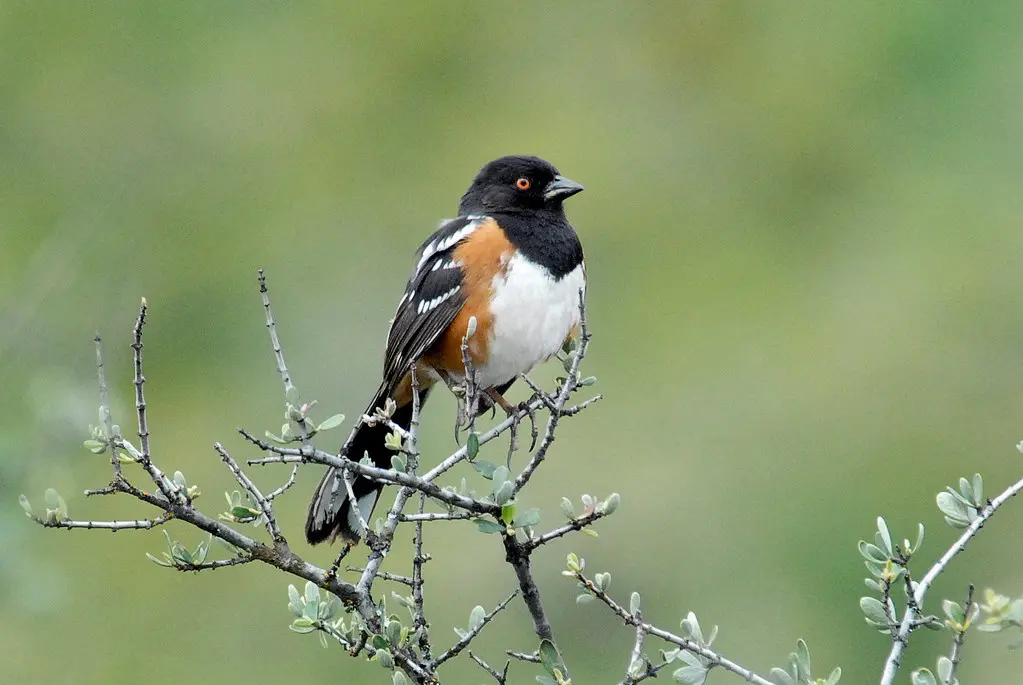
Image Source
- Scientific name: Pipilo maculatus
- Lifespan: Up to 9 years
- Size: Approximately 18-21 cm (7-8 inches)
- Native to: Western North America
The Spotted Towhee is a medium-sized songbird found in North America, primarily in the western United States and parts of western Canada. Adult Spotted Towhees have a distinctive appearance with a black head, upperparts, and wings, contrasted by rufous sides, a white belly, and white spots on their wings and back. They have bright red eyes.
These towhees are often found in a variety of habitats, including woodlands, shrubby areas, and gardens. They are primarily ground foragers, scratching the leaf litter and soil for insects, seeds, and plant matter.
Spotted Towhees are appreciated for their bold and territorial nature, as well as their striking plumage. They are known for their vocalizations, which include a series of clear and melodious whistles and trills. They are often seen foraging on the ground and are a common sight in many parts of their range.
Rockjumper

- The Drakensberg Rockjumper (Chaetops aurantius) and the Cape Rockjumper (Chaetops frenatus). Both are endemic to South Africa.
- Lifespan: Information on lifespan is limited.
- Size: Medium-sized songbird; specific measurements may vary.
- Origin: Found in the rocky habitats and alpine areas of South Africa, particularly the Drakensberg Mountains and the Cape region
The Rockjumper is a group of bird species found in sub-Saharan Africa. There are several species within the Rockjumper group, including the Cape Rockjumper and the Drakensberg Rockjumper, each with its own distinct range and habitat preferences.
Rockjumpers are known for their terrestrial habits and unique foraging behavior. They are often found in rocky and mountainous habitats, where they feed on insects and other invertebrates that hide in rock crevices.
Rockjumpers are appreciated for their adaptation to challenging terrain and their specialized feeding habits. They are often associated with high-altitude landscapes and are a sought-after group for birdwatchers interested in observing avian species that inhabit rugged and remote areas.
Red-eyed Puffback

- Scientific name: Dryoscopus senegalensis
- Lifespan: The specific lifespan of Red-eyed Puffbacks in the wild is not well-documented, but similar birds in the bushshrike family can live for about 5-10 years.
- Size: Small to medium-sized songbird; about 5.5-6 inches (14-15 cm) in length.
- Range: Native to sub-Saharan Africa, and it is found in a wide range of countries across the continent
The Red-eyed Puffback is a small songbird found in sub-Saharan Africa. Adult male Red-eyed Puffbacks have a distinctive appearance with glossy black plumage, a conspicuous red eye, and a fluffy, white “puffback” on their backs during the breeding season. Females, however, lack the puffback and have more subdued plumage.
These puffbacks are often found in a variety of wooded habitats, including woodlands, forests, and savannas. They are insectivorous, foraging for insects and other small invertebrates in the foliage.
Red-eyed Puffbacks are appreciated for their striking appearance, especially the males during the breeding season when their puffback is fully displayed. They are often heard before they are seen, as they produce a variety of vocalizations, including melodious whistles and chirps.
Final Thoughts on Black Birds with Red Eyes
As we conclude our journey through the enigmatic avian world, we’ve uncovered the mesmerizing allure of black birds with red eyes. These captivating creatures, with their striking contrast, remind us that nature’s mysteries are often hidden in plain sight.
Throughout our exploration, we’ve celebrated their unique appearances and gained insights into their habitats, behaviors, and the intriguing secrets behind their crimson gaze. These birds serve as a living testament to the wonders and diversity of the natural world.
Further Readings
- Black Birds with Red Heads
- Black Birds with Greeb Heads
- Black Birds with Yellow Heads
- Black Birds with yellow wings
- Black Birds with White Bellies
- Black Birds with Yellow Beaks
- Black Birds with Orange Wings
- Black Birds with White Stripes on Wings
- Black Birds with White Spots
- Black Birds with Gray Heads
List of Black Birds with Red Eyes
- Metallic Starling
- Black Guan
- Inaccessible Island Rail
- American Coot
- Junin Grebe
- Spotted Towhee
- Phainopepla
- Western Grebe
- Greater coucal
- Bronzed cowbird
- Common Loon
- Red-eyed puff back
- Spangled drongo
- White-winged Chough
- Asian Koel
- African Oystercatcher
- African River Martin
- Asian fairy-bluebird
- Asian glossy starling
- Dusky tit
- Rockjumper

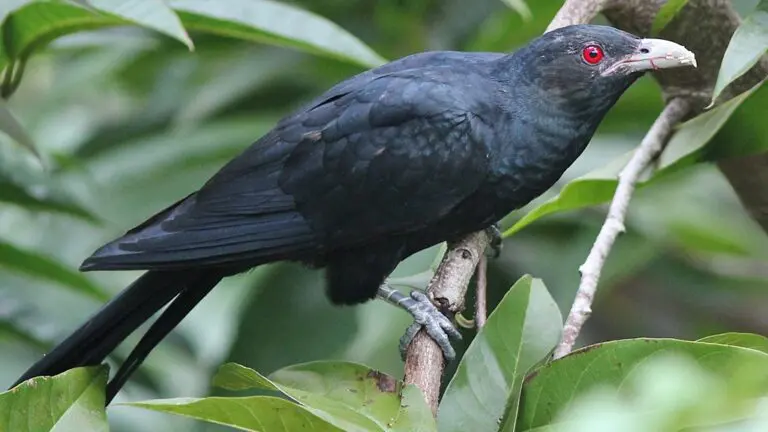
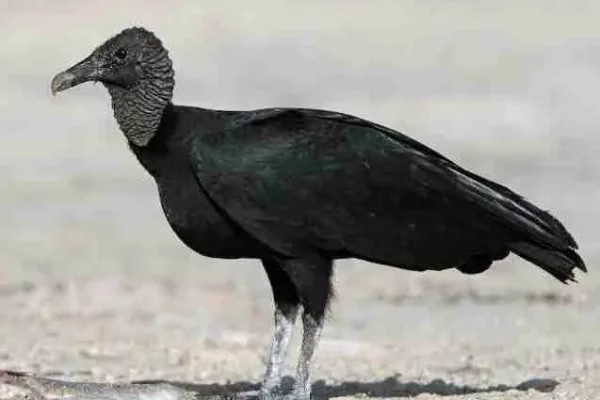
![20 Stunning Black Birds with White Bellies [Images + IDs]](https://birdsology.com/wp-content/uploads/2023/05/51891956448_e0135058a2_b-600x400.jpg.webp)
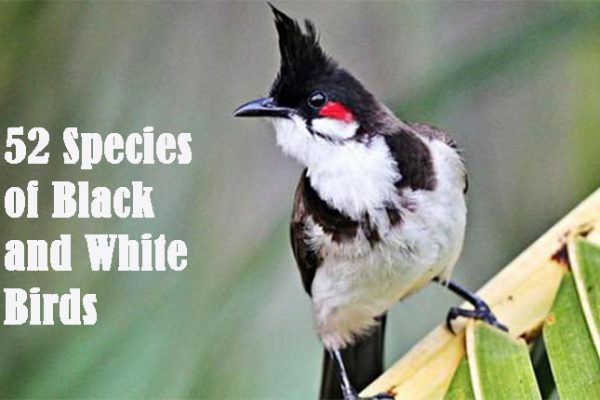
![18 Black Birds With White Spots [Images + IDs]](https://birdsology.com/wp-content/uploads/2023/06/51661897701_dd85d788d6_b-600x400.jpg.webp)